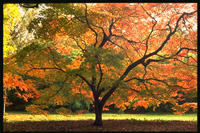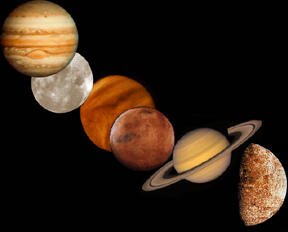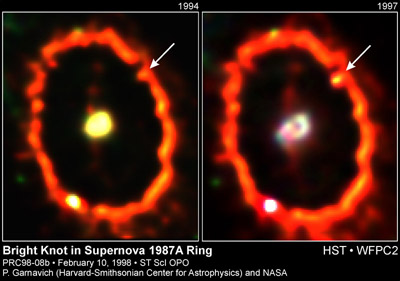Recent HST obervations show a brightening knot on the upper righthand corner of this image. This is the site of the collision between the outward moving blast wave and the innermost circumstellar ring.
Click on image for full size
Image courtesy of Hubble Space Telescope
Titanic Stellar Explosion
News story originally written on March 4, 1998
Shock waves from supernova explosion collide with gas ring!! Traveling at 40 million mph, a wave of energy released in a supernova explosion has begun to collide with a ring of gas surrounding the area of the explosion.
The supernova explosion was first observed on February 23, 1987. Although the star actually blew up in about 165,000 BC, the light from the explosion had just arrived at Earth. This is the closest supernova to Earth in 400 years.
The ring of gas around the explosion was formed before the star exploded. As the debris from the supernova hits the ring at extreme speeds, the temperature of the ring increases from a few thousand degrees to a million degrees Farenheit! In a few years, the entire ring will have lit up. The lit ring is expected to also light up the space around it, shedding light on objects that were previously too dark to see.
Astronomers are expecting to be able to answer questions about the supernova's past, such as what type of star caused the explosion, and explain things about the strange gas rings surrounding the supernova.
You might also be interested in:

It was another exciting and frustrating year for the space science program. It seemed that every step forward led to one backwards. Either way, NASA led the way to a great century of discovery. Unfortunately,
...more
The Space Shuttle Discovery lifted off from Kennedy Space Center on October 29th at 2:19 p.m. EST. The weather was great as Discovery took 8 1/2 minutes to reach orbit. This was the United States' 123rd
...more
A moon was discovered orbiting the asteroid, Eugenia. This is only the second time in history that a satellite has been seen circling an asteroid. A special mirror allowed scientists to find the moon
...more
Will Russia ever put the service module for the International Space Station in space? NASA officials want an answer from the Russian government. The necessary service module is currently waiting to be
...more
A coronal mass ejection (CME) happened on the Sun early last month. The material that was thrown out from this explosion passed the ACE spacecraft. The SWICS instrument on ACE has produced a new and very
...more
J.S. Maini of the Canadian Forest Service called forests the "heart and lungs of the world." This is because forests filter air and water pollution, absorb carbon dioxide, release oxygen, and maintain
...more
In late April through mid-May 2002, all five naked-eye planets are visible at the same time in the night sky! This is includes Mercury which is generally very hard to see. You won't want to miss this!
...more















